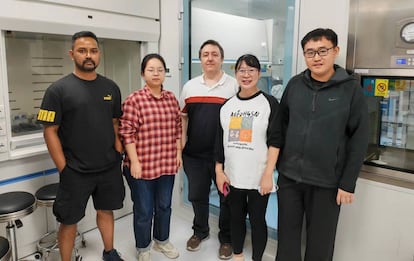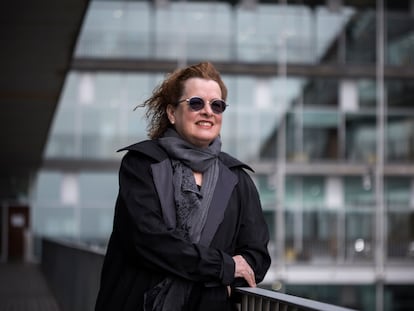The most advanced chimeric monkey yet is born
Spanish scientist Miguel Angel Esteban has joined forces with Chinese researchers to create a primate that has two thirds of its cells from another monkey embryo and could help with research on human disease, such as Alzheimer’s

A team of Chinese researchers together with Spanish scientist Miguel Ángel Esteban have just announced the birth of a monkey in a laboratory in Shanghai with cells from two different monkey embryos. The scientific community calls these hybrid organisms chimeras, like the mythological monster that has the head of a lion, the belly of a goat and the tail of a dragon. This is the furthest research has gone with macaque chimeras. Researchers claim that these creatures may have potential for medical research should they be generated with diseases that accurately mimic human ones, such as Parkinson’s and Alzheimer’s.
An embryo begins with an egg fertilized by a sperm. The single resulting cell will divide and give rise to a few totipotent cells capable of becoming a complete embryo and so generating a complete animal, including the placenta. These totipotent cells generate other pluripotent cells, which can also give rise to any type of cell in the organism — brain, bone, liver, muscle — but no longer to the placenta. In 2012, Kazakh-American biologist Shoukhrat Mitalipov and his team succeeded in producing the birth of chimeric monkeys for the first time by aggregating totipotent cells from different embryos.
Chinese scientist Tianqing Li’s group went a step further in 2018. From a single embryonic cell, he managed to grow a line of pluripotent stem cells in his laboratory, such that they continue to multiply indefinitely but without differentiating into specialized tissues. Tianqing Li’s team injected these laboratory cells into a macaque embryo and also achieved the birth of chimeric monkeys, but the contribution barely reached between 0.1% and 4.5% of the cells.
Now Esteban, 53, from the Guangzhou Institute of Biomedicine and Health, and his Chinese colleagues have made a gargantuan leap. The researchers removed cells from embryos as young as seven days old and obtained cell lines capable of multiplying indefinitely in the laboratory. They then labeled these pluripotent stem cells with green fluorescent protein from a jellyfish, before finally injecting those cells into four-day-old monkey embryos. Twelve pregnant females gave birth to six offspring, but only one of the newborn monkeys had a high percentage of chimerism in the brain, heart, kidneys, liver and other organs — between 21% and 92%, depending on the tissue.

“The big leap is to go from a low contribution to a percentage where you can say this is a real chimeric animal,” says Esteban. The average achieved was 67% — in other words, two out of every three cells. Fluorescent green could be seen in the eyes and fingertips of the monkey — a crab-eating macaque. Suffering respiratory failure and hypothermia, the animal was euthanized at 10 days old. The results have just been published in the scientific journal Cell.
The Spanish biologist Marta Shahbazi explains the relevance of the new study, pointing out that the technique of chimeras in mice, developed in 1989, was already “a revolution” because it made it possible to generate genetically modified rodents, thanks to the manipulation of embryonic stem cells that reproduce indefinitely in the laboratory. “If we want to know what the function of a gene is in a mouse, we can eliminate the gene in the embryonic stem cells and then use these modified cells to generate chimeras. If the cells contribute to eggs and sperm, some of the offspring of the chimeric mice will have the gene deleted in all the cells of their body and we can analyze what happens to them, and therefore discover the function of the gene,” says Shahbazi, from the Laboratory of Molecular Biology, Cambridge, U.K.
The scientists behind this technique in mice, the Italian Mario Capecchi and Oliver Smithies and Martin Evans, both from the U.K., won the 2007 Nobel Prize for Medicine. “In the case of monkeys, if chimeras could be generated efficiently, we could study the consequences of deleting or modifying specific genes in monkeys,” Shahbazi notes. “It is important to mention that in this new study only one chimeric monkey was born, so we’re still at a low level of efficiency.”
The macaque with cells from two different embryos was born at the Laboratory of Primate Neurobiology at the Chinese Academy of Sciences in Shanghai. Esteban’s team collaborated with the teams of his colleagues Qiang Sun and Zhen Liu. Esteban himself had already announced the generation of a humanized kidney in a pig embryo two months ago, in an experiment on the frontier of bioethics. It was the first human organ created inside an animal and has brought the dream of manufacturing spare organs for people needing transplants that bit closer.
Esteban tells EL PAÍS that his new technique for obtaining chimeric monkeys, based on a specific chemical cocktail, could represent “a spectacular advance” in the genetic modification of primates, by making it possible to introduce multiple mutations and markers to find out which cells are altered. Besides mimicking human diseases in laboratory animals, the scientist says, “If human cells acquire this same level of pluripotency, they could separate into tissues in vitro that would, in principle, closely resemble embryonic tissues. This could be used for cell transplants or to study diseases in a laboratory dish.”
The Spanish scientist, who hails from the Valencian town of Castellón de la Plana, says the research could also be applied to species conservation. The monkey born in Shanghai had cells from two different embryos of the same species. But Esteban points out that the technique could be carried out with two different species: one in imminent danger of extinction and the other in a good state of conservation, so that the resulting chimera would have eggs or sperm from the endangered species. “We could create embryonic cell banks of different species of monkey and use this type of technology for the conservation of non-human primates.”
Sign up for our weekly newsletter to get more English-language news coverage from EL PAÍS USA Edition
Tu suscripción se está usando en otro dispositivo
¿Quieres añadir otro usuario a tu suscripción?
Si continúas leyendo en este dispositivo, no se podrá leer en el otro.
FlechaTu suscripción se está usando en otro dispositivo y solo puedes acceder a EL PAÍS desde un dispositivo a la vez.
Si quieres compartir tu cuenta, cambia tu suscripción a la modalidad Premium, así podrás añadir otro usuario. Cada uno accederá con su propia cuenta de email, lo que os permitirá personalizar vuestra experiencia en EL PAÍS.
¿Tienes una suscripción de empresa? Accede aquí para contratar más cuentas.
En el caso de no saber quién está usando tu cuenta, te recomendamos cambiar tu contraseña aquí.
Si decides continuar compartiendo tu cuenta, este mensaje se mostrará en tu dispositivo y en el de la otra persona que está usando tu cuenta de forma indefinida, afectando a tu experiencia de lectura. Puedes consultar aquí los términos y condiciones de la suscripción digital.











































